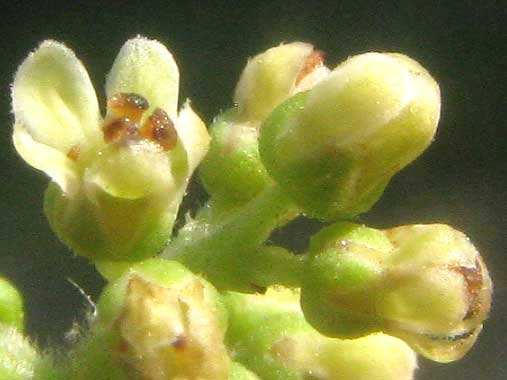Excerpts from Jim Conrad's
Naturalist Newsletter

from the July 8, 2012 Newsletter issued from the woods of the Loess Hill Region a few miles east of Natchez, Mississippi, USA
WINGED SUMACS FLOWERING
Later in the year, with its bright red leaves and fruits, one of the most colorful bushes or small trees in our landscape here will be what's called the Winged or Shining Sumac, RHUS COPALLINA. Nowadays Winged Sumac is producing dense, cantaloupe-sized heads of tiny, greenish-cream, pollinator-attracting flowers, as shown above.
In that picture notice that the rachis, or "stem," of the long, pinnately compound leaf projecting toward the picture's top, right corner is "winged" -- bears flat, green leafy tissue held in the same plane as the leaflets. These rachis wings are distinctive of the species, making this one of the easiest-to-identify woody plants in our area, and accounting for the name Winged Sumac. Who knows what purpose the wings serve? In the Northeast a similar species, the Staghorn Sumac, also has compound leaves but does perfectly well without wings along its rachises.
A close-up of some female Winged Sumac flowers, whose petals are only about 2mm long (3/16ths inch), is shown below:

In that picture you see that each flower consists of a green calyx with five sepals, five cream-colored petals, and inside each flower arises a hairy, green ovary with three styles topped with brownish stigmatic areas where pollen grains germinate. Sumacs can bear flowers with only female parts, such as these, as well as flowers with both male and female parts, and male-only flowers, in which the pollen-producing stamens project conspicuously from the blossom, with no evident female parts.
During my hermit days I loved collecting Winged Sumac fruits. A handful in a pot of boiling water produced a very nice tea, sour like lemonade. Sumac-tea purists would regard that as barbaric, though, since boiling water tends to leach out too much tannic acid, causing the brew to be a bit bitter. It's better to put the fruits in a bowl of water and squeeze them together, breaking up the acid glands on the hairs covering the fruits. Then strain out the fruits and heat the water. The fruits also can be dried and ground to make a lemony spice that can be kept on the shelf.
Medicinally, as you'd expect of anything producing acidy fruits and containing lots of tannin, Native Americans used it for many purposes -- dysentery, mouth sores, skin eruptions, etc.
from the November 2, 2003 Newsletter issued from the woods of the Loess Hill Region a few miles south of Natchez, Mississippi; elevation ~200ft (~60m), ~N31.42°, ~W91.41°; USA
SUMAC TEA
Those chilly mornings earlier this week got me in the mood for some sumac tea, so I visited a thicket of sumac near the barn and snipped off a few clusters of fruits. Back at the camp I dropped the clusters into a pot of boiling water and after a while had some tea. It's sour stuff, made eminently better with the addition of sugar or honey, and milk or cream.
The acid taste comes from the bursting of tiny glands at the tips of very small, stiff hairs covering the fruits. When these glands burst they release acid into the hot water. When you collect the fruits you can clearly see the glands with a good handlens, and just barely see them with your naked eye. So many acid- filled, hair-top glands cover each fruit that the fruits look and feel a bit sticky.
I've been noticing sumacs for a few weeks. Among the very first harbingers of fall, they show up as random splashes of scarlet in the landscape. Now they are a little past their color peak and are losing leaves. Many of the remaining leaves are black, and the fruiting clusters are brown and drooping at the ends of branches.
The sumac we have here is the Winged Sumac, RHUS COPALLINA. Many books refer to it as Shining Sumac. In fact, the English naming of this plant has always been a bit shaky. The dictionary accepts an alternative spelling of "sumac" as "sumach," plus they say it can be pronounced either "SHOO-mak" or "SOO-mak." The word "sumac" appears to have come into English from the Arabic "summaq" by way of Middle Latin and Old French, so there's no wonder its pronunciation is squishy by now.
Some people worry about making sumac tea because they've heard of Poison Sumac, Toxicodendron vernix. Poison Sumac does occur in southern Mississippi, but I've not seen it around here. It lives only in very moist spots such as bogs, pocosins, wet pine barrens and stream borders. Certainly it wouldn't be growing in our weedy, upland fields.
When gathering fruits for making tea it's easy to be sure you're not getting Poison Sumac fruits. Winged Sumac fruits are red while Poison Sumac fruits are white, like those of Poison Ivy. In fact Poison Sumac and Poison Ivy belong to the same genus, so they share lots of traits. Our Winged Sumac is in the same family as they -- along with the trees producing cashews, mangos, and pistachios.